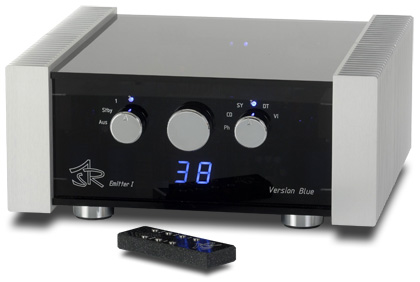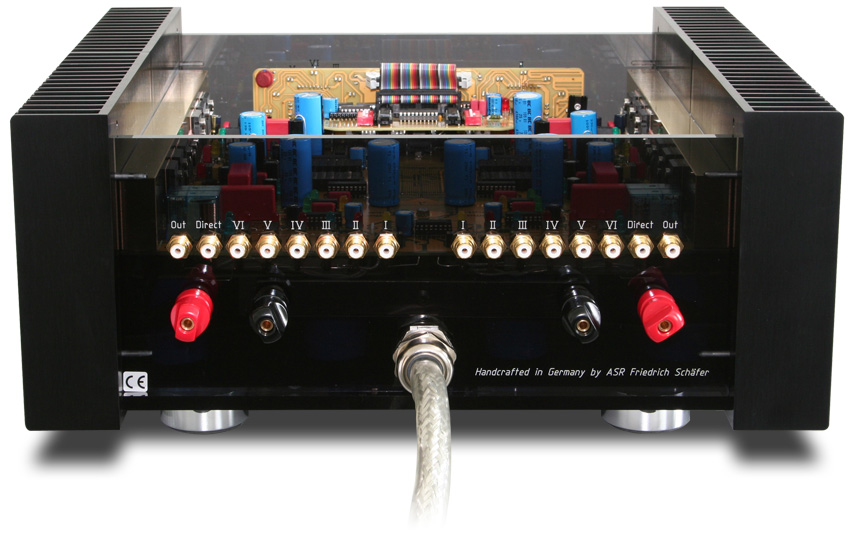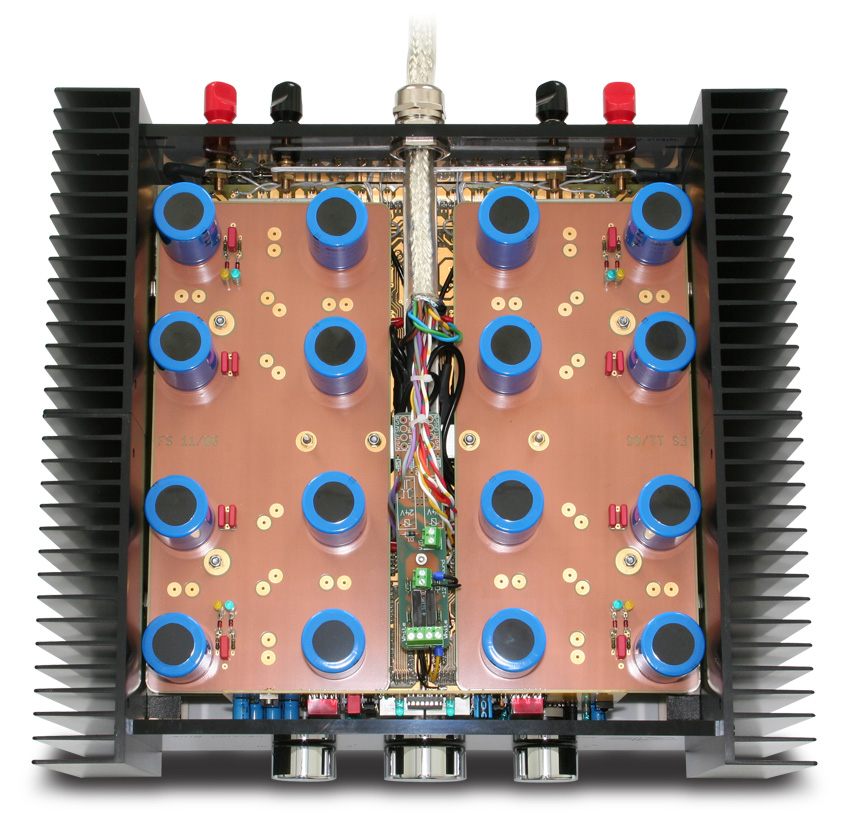 August 2010
ASR
Emitter I Integrated Amplifier
|

|
Associated Equipment
Speakers
-- Wilson Audio Specialties Sophia, Audioengine A2
Integrated amplifier
-- Jeff Rowland Design Group Concentra
Sources
-- Wadia 830 CD player, Logitech Transporter, Apple
MacBook, Devilsound USB DAC
Interconnects
-- Cardas Audio Neutral Reference
Speaker cables
-- Cardas Audio Neutral Reference
Headphones system --
Sennheiser HD 600 with Cardas headphone cable upgrade,
Ultimate Ears UE 11 Pro, Ray Samuels Audio Emmeline The
Predator
Accessories
-- Audio Power Industries Power Pack II, Cardas Audio
Signature XLR, RCA and BNC caps
|
|
|
|
 Iím
no slave to dogma, but Iíve clung to a few personal truths about
home audio that Iíve been unabashed to share with anyone whoís
bothered to ask. No. 1 is that the bulk of an audio budget should go
to the loudspeakers, in the belief that they make the single largest
contribution to the overall sound of a system, and that the rest of
the money should be spent on the source and amplification
components. Recently, however, Truth No. 1 was upended. Iím
no slave to dogma, but Iíve clung to a few personal truths about
home audio that Iíve been unabashed to share with anyone whoís
bothered to ask. No. 1 is that the bulk of an audio budget should go
to the loudspeakers, in the belief that they make the single largest
contribution to the overall sound of a system, and that the rest of
the money should be spent on the source and amplification
components. Recently, however, Truth No. 1 was upended.
ASR Audiosysteme, founded in 1980 by Friedrich
Schaefer, is a German maker of electronics with the stated goals of
ďreproducing music as a complete experienceĒ by combining ďthe
harmony and musical sound of tubes with the accuracy and sovereign
power distribution of modern transistor amplifiers.Ē ASR
manufactures phono preamplifiers, but their best-known products are
the Emitter I and Emitter II. Although both are
integrated
amps, ASR designed each as a power amp with a gain stage and volume
control, for the purest signal path possible. The Emitter I has been
in production for 30 years, during which time its circuit design and
parts content have been continually refined and updated. That
apparent total confidence in the design and implementation of the
product is one way to explain why these amps are so rarely available
secondhand.
Description
The ASR Emitter I ($10,950 USD as reviewed) is
a solid-state, MOSFET-equipped integrated amplifier with
a separate
power supply that connects via a hefty 2.0m umbilicus. The Emitter I
is also equipped with its own heavy-gauge AC cord, though ASR warns
that this not
be replaced with an aftermarket cord, and that the power supply
should be plugged directly into the wall outlet instead of a power
conditioner. Because ASR believes that metal is too resonant to be
used in casework and can adversely affect the signal, much of the
Emitter I (except for those parts that
must be made
from other metals) is enclosed in acrylic.
From an aesthetic standpoint, Iíve never been a fan of the use of
acrylic in stereo gear, but the Emitter I is beautiful -- photos
really donít do it justice. ASRís rather dated-looking logo aside,
the amp is gorgeous; the visible glow of the LEDs on the internal
circuit boards elicited positive comments from everyone who saw
them. The Emitter I is available with casework of clear or black
acrylic. Both are beautiful; Iíd have a hard time choosing between
them. Thereís also the Emitter I Version Blue, an $850 upgrade
(cosmetics only) in which the front LEDs are blue, the heatsinks can
be specified as black or silver, and the brass feet are chrome.
The main amp measures 16"W x 7"H x 16"D and weighs 42 pounds. The
standalone power supply, which contains two 500VA transformers and
provides a whopping 406,440ĶF of capacitance, measures 18"W x 6.3"H
x 12.5"D and weighs a hefty 68 pounds, despite being smaller
overall. The Emitter I is claimed to output 140Wpc into 8 ohms or
250Wpc into 4 ohms, so it should have no trouble powering most
speakers. The frequency response is stated as 1Hz-100kHz, +/-1dB,
and 20Hz-20kHz, +/-0.2dB, with a maximum distortion of 0.01% and a
damping factor of over 600. While my review sample came with the
standard AC power supply, a battery power supply is available as an
option.
Each side panel of the main amplifier is a massive heatsink. Despite
my long listening sessions, sometimes at high volume, these sinks
never became uncomfortably hot to the touch. On the front panel is a
central volume control knob of polished chrome that is silky-smooth
in action, with a feel that reminded me of a fine Swiss watch. Below
this is a LED display that indicates the volume level, in digits
large and bright enough to be seen from across a big room. Flanking
the volume control are two more polished knobs, the left for
Power/Standby and the right for Source selection.
At the center of the rear panel is a fixed
umbilicus whose other end attaches to the rear of the power supply
with a massive clamp. Flanking that are pairs of hefty speaker
binding posts. These can be hand-tightened; they tightly gripped the
spade lugs of my speaker cables. The top of the rear panel can
include a pair of balanced XLR inputs (a $400 option); below these
are six pairs of RCA inputs and one pair of RCA outputs. These are
standard, high-quality, Teflon-insulated jacks; better copper or
silver WBT models are offered as an upgrade. Supplied with the
Emitter I is a small Corian remote that controls the volume, input
selection, and mute, and comfortably fit my palm.

Setup
If, like mine, your listening room is
not
on the ground floor, youíll find it best to uncrate the Emitter I
and its power supply at ground level anyway -- the size and weight
of the shipping containers make them unwieldy. Even so, great care
must be taken; this fairly compact amp and power supply --
especially the latter -- are surprisingly heavy. Once Iíd unboxed
both components, I wrestled them into place on the floor on opposite
sides of my component stand, and proceeded to connect the umbilicus
from the power supply to the amp, then hook up my sources and
speakers. Only then did I plug in the power supply. Set up was
pretty straightforward; I barely consulted the ownerís manual.
As usual, I began by
playing music in the background to let the amp warm up while I did
something else (reading the ownerís manual or a magazine, surfing
the Internet). After a decent interval, I set out to evaluate the
Emitter Iís sound.
Surprise, surprise,
surprise . . .
After firing up the Emitter I, my first thought
was Hmmm,
this is one cool-sounding amp -- not
cold, hard, or analytical, but definitely not what Iíd expected. At
first, I assumed that the amp needed to be broken in, but this
characteristic persisted even after extended listening over several
days. However, this impression of coolness was dispelled when it
dawned on me that what I was hearing was not a cool-sounding amp,
but the complete absence of any sonic artifacts that would otherwise
obscure the sound. My second thought was
Now this
is high-resolution sound.
Thatís how profound a difference the Emitter I made with my system.
Transparent
doesnít begin to describe the sound of the Emitter I; it was as if a
window on the recording venue had opened, to reveal sonic images
that were almost tactile. These images were not hyperrealistic, as
if etched with lasers, but were fully formed, holographic, and
organic.
I dislike the characterization
sonic bloom, but thatís exactly what I
heard -- the music opened up in a way I had never before
experienced. Rather than present the music as beautifully
reproduced
sound, the Emitter I did more to re-create what sounded like a
live
event than any other component Iíve heard.
The soundstaging was outstanding. The Emitter I
projected a wider and, more important, deeper soundstage that really
brought to life recordings of unamplified instruments. I love ECM
recordings for their rich warmth and lush, natural tone; the first
track I played was ďBlessed Feet,Ē from the Tord Gustavsen Trioís
Being There
(CD, ECM 2017). It begins
with a quiet backbeat from the drums, followed by piano and bass
together, with slight variations on pianist Gustavsenís gorgeous
melody. As Gustavsen plays, letting the melody develop and progress,
I was amazed that this studio recording could come so close to the
sound and feel of a live performance. My main complaint with studio
recordings is that the reverb used to add space and body often
results in a feeling of artifice. The Emitter I went a long way
toward eliminating this with its reproduction of the soundstage and
by ameliorating the artificial effect of the reverb, which allowed
for a natural-sounding decay that was especially notable at the end
of the track. All I can say is, Wow!
The Emitter Iís transparency meant that there
was no grit or grain in the treble, and the highs were light and
airy, notes floating in the space defined by the soundstage. In the
recording of Beethovenís Symphony No.6 with Claudio Abbado
conducting the Berlin Philharmonic (CD, Deutsche Grammophon 469-003
2), the Emitter I displayed a delicate touch with the smooth
textures of the violins, while still allowing for heft, as needed,
down below. And as far as Iím concerned, in the midrange the Emitter
I has no peer. The tonally uncolored ASR let the midrange flow from
my speakers unfiltered in a most neutral manner, without adding any
unneeded warmth or glow. On the title track of Shelby Lynneís
Just a Little Loviní
(CD, Lost Highway
1744825), she often sounds as if sheís singing too close to the mike
-- her voice sounds overripe, tonally too rich. Through the Emitter
I, Lynne seemed to take a step back from the mike, while still
conveying the songís immediacy and emotional texture.
With the exception of the low end, Iíve
described all of the individual characteristics of the Emitter I,
but no track better illustrated how this amp stitched everything
together into one cohesive whole than ďDark Star,Ē from the Grateful
Deadís Nightfall of Diamonds
(CD, Grateful Dead GDCD4081). I may be a heretic among Deadheads for
preferring this version of this iconic track, but in addition to an
otherworldly performance, itís a sonic delight. Through the Emitter
I, all of the textures and soundscapes that the late-era Dead (this
show was taped in 1989) was capable of creating were there in all
their glory, along with the low-end weight and impact of Phil Leshís
bass and Brent Mydlandís synthesizers. Awesome-sounding stuff! And
although Iíve heard tighter bass control with one other amp (see
below), the Emitter I was only a smidgen less firm while being just
as tuneful, and still able to keep a firm grip on the low end.
ďDark StarĒ was also useful in highlighting the Emitter Iís dynamic
performance. I could turn up the volume to very high levels with no
sense of strain; the more I turned up the power, the more the music
opened up to reveal layers and layers of sound. I reveled in that
sound -- it was as if waves of music were washing over me.

Clash of the Titans
Like the Luxman L-509u
($10,000) and the Esoteric A-100 ($19,000) integrated amplifiers,
both of which Iíve reviewed, the ASR Emitter I is in a class that so
far exceeds the performance of my Jeff Rowland Design Group
Concentra integrated ($5600, when available) that any comparison to
the latter would be unfair to both. However, sonic and financial
comparisons of the Emitter I with the L509-u and A-100 are certainly
fair.
All three amps are very
quiet, with extraordinary dynamic range that seems to exceed their
stated power outputs, especially the Esoteric A-100. The A-100 was
most like the Emitter I in terms of dynamic range and overall
headroom, but seemed a little softer in the treble, with a bit more
midrange warmth that was likely the result of its tube-based
circuitry. As noted above, only one other amp in my experience has
had tighter bass control than the Emitter I, and that is the Luxman
L509u, which has bass to die for. But while both of these amps
compared favorably with the Emitter I, and had individual
characteristics that equaled or bettered the ASRís, the Emitter I
was simply more transparent, more cohesive, and a better all-around
performer. I could easily live with any of the three, and until now
the L-509u has been my favorite. But if I now had to choose only
one, it would have to be the ASR Emitter I.
Conclusion
The Emitter I is a fantastic product thatís so
close to the audiophile ideal of a straight wire with gain that itís
hard to believe thatís true without hearing it for yourself. In
earlier reviews Iíve tried hard to avoid hyperbole, and in writing
this one Iíve had to try even harder. When the importer told me to
guess the Emitter Iís price, I figured it was close to $20,000. I
was astounded to learn that the base price is $10,000: Although by
no means inexpensive, the Emitter I costs the same as the Luxman
L509-u and only half as much as the Esoteric A-100, but comes with
its own separate power supply, jewel-like build quality,
and
excellent sound -- all of which makes it the much better value.
I mentioned at the beginning of this review
that I used to believe that the bulk of an audio budget should be
allocated to the speakers. After hearing the ASR, I now believe
that, in this case, Iíd give equal weight to the speakers and the
Emitter I and spend far less on a digital source, confident that any
compromise in sound quality would be little to nonexistent. Some
ďtruthsĒ are meant to be shattered, and Iím happy to chuck this one
in the dustbin. The only thing Iím
not happy about is sending back the
Emitter I. God, Iím gonna miss it.
. . . Uday Reddy
udayr@soundstagenetwork.com
|
ASR Emitter I Integrated Amplifier
Price: $10,950 USD as
reviewed.
Warranty: Two years parts and
labor.
ASR Audiosysteme
Hohe Strasse 700, Haus 5A
Herborn D-35745
Germany
Phone: +49 (27 72) 4 29 05
Fax: +49 (27 72) 4 04 88
Email:
info@asraudio.de
Website:
www.asraudio.de
North American
distributor:
Musical Sounds, LLC
Connecticut,
USA
Phone: (203) 877-7776
Email:
zed@musicalsounds.us
Website:
www.musicalsounds.us
|
|

